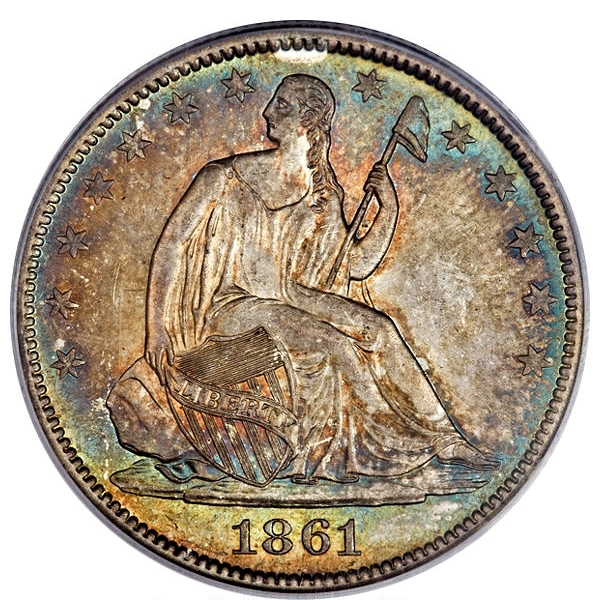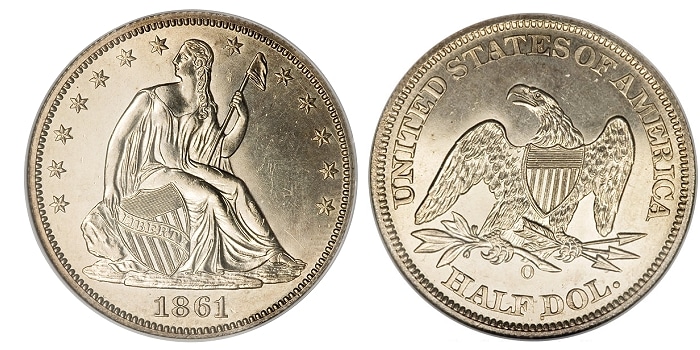By Dan Duncan – Retired, Pinnacle Rarities ……
Description
The 1861 half dollars from the New Orleans Mint have the distinction of being the only issue in U.S. numismatics struck under the authority of three different authorities. At the time, all working dies were prepared in Philadelphia and distributed to the branch mints as no tooling or die preparation equipment was readily available at the branch mints. Dies were prepared and delivered to New Orleans in December 1860.
The resolutions of secession were passed that same month, but Mint operations remained under Union rule through January 1861. The dies issued to the New Orleans Mint were used to strike 330,000 coins that were delivered to the Union successfully. The Confederate States desperately needed gold and silver to fund the war effort. And in February, officials from the Confederacy took over the New Orleans Mint, forcing allegiance from all incumbent employees. In March, the branch struck a reported 1,240,000 more O-mint halves under orders from the State of Louisiana. Soon after, the state relinquished operations to the CSA.
Confederate Secretary of the Treasury C.G. Memminger worked toward creating coinage for the Confederacy. He tapped local die maker A.H.M. Patterson to create a new obverse. The Patterson dies were paired with the Union Liberty Seated obverse and four Proof examples were struck. The project failed to advance further and the CSA produced halves using the dies provided previously by the Union. Under their authority in April, the Mint produced a final 962,633 coins.
Recognizing that efforts to obtain and secure enough bullion to continue production would be too great, Memminger shuttered operations in May 1861. The Mint was eventually recaptured by Union forces in June 1862 and summarily vandalized. It didn’t produce any coinage until 1879 and no O-Mint halves were produced until 1892.
All New Orleans Mint coins produced by the Union, Louisiana, and the Confederacy were done using 12 die pairs. Differentiating between the three producers is virtually impossible but with one exception. During usage to create coins for the CSA, the obverse cracked from the rim to the nose of Liberty. This die remained in use by the Confederates to produce additional halves. This late die state serves as an indication of strikes made under the orders of the CSA. Examples that display this die marker command a premium and are termed the “Confederate obverse”.
Design
Obverse:
The obverse was designed by Christian Gobrecht based on drawings by Thomas Sully. It features Lady Liberty seated on a rock. Leaning against the rock is an escutcheon of stripes and bars with a ribbon diagonally across bearing the inscription LIBERTY. The shield is supported by Liberty’s right hand and in her other, she holds a Liberty pole topped with a Phrygian cap. The central devices are surrounded by 13 stars with the date below.
Reverse:
The reverse, based on previous coinage designed by German-American engraver John Reich, displays a heraldic eagle at its center with a shield of stripes and bars across the breast. In the talons are arrows and olive branches. Above the bird in the periphery are the words UNITED STATES OF AMERICA, and below is the denomination HALF DOL.
Edge:
The edge of the 1861-O Seated Liberty half dollar is reeded.
Confederate Strikes and Restrikes
Four examples are known to have been struck using the Patterson CSA dies (B-8000). These went to Memminger, who gave his example to Confederate President Jefferson Davis. Another was given to John Leonard Riddell of the University of Louisiana. Dr. E. Ames, a prominent doctor in the city, received one. Another is said to have gone to the engraver of the die, but this example has yet to surface. The final piece, along with the dies, was kept by B.F. Taylor, Chief Coiner at the New Orleans Mint.
Taylor feared that discovery of the dies and coin would label him a traitor. He kept the items in secrecy until 1879. The dies and the coin were sold to Philadelphia numismatist Ebenezer Locke Mason, Jr. He sold them to J.W. Scott. Scott smoothed the reverses of 500 genuine 1861 half dollars and struck over the blank side to create Confederate restrikes (B-8002). These are easily identifiable for their flattened seated obverse features. A few prototypes (B-8001) were created and their weights match correctly to the Union specifications at 12.44 grams. The smoothed reverse examples represent the bulk of the restrikes and weigh less than the specified 12.44 grams. Scott struck medals on white metal (B-8003) using the Patterson die, creating his own obverse die that imparted the inscription “4 ORIGINALS STRUCK BY ORDER OF CSA IN NEW ORLEANS 1861/REV. SAME AS U.S. (FROM ORIGINAL DIE * SCOTT).”
The four known original Proofs are extremely valuable and rarely enter the market. The 1861 Seated half dollar Scott restrikes surface occasionally and are highly prized. The medal restrikes surface with some frequency, but they are still valuable and rare. Many copies have been made since 1879; these are interesting novelties but carry little numismatic weight.
Designer(s)
Second-generation German-American Christian Gobrecht served as Chief Engraver at the United States Mint from 1840 to 1844, having served as “Second” Engraver since 1835. He may even have worked at the mint in Philadelphia as early as 1823. Gobrecht is responsible for the popular Liberty Seated motif found on all Seated Liberty coinage, as well as the Gobrecht dollar struck from 1836 through 1838. Gobrecht died in 1844.
Coin Specifications
| Country: | United States |
| Year Of Issue: | 1861 |
| Denomination: | 50 cents |
| Mint Mark: | O (New Orleans) |
| Mintage: | 2,532,633* |
| Alloy: | 90% Silver, 10% Copper |
| Weight: | 12.44 g |
| Diameter: | 30.6 mm |
| Edge | Reeded |
| OBV Designer | Christian Gobrecht |
| REV Designer | Christian Gobrecht |
| Quality: | Business Strike |
* Records from the New Orleans Mint during this era are incomplete. The breakdown of Louisiana State strikes and CSA strikes is debatable with numbers reported by Walter Breen consistent with the Redbook overall figures. Q. David Bowers reports a total of 2,562,000, attributing more strikes to the CSA than Breen and less to Louisiana. Both agree on the 330,000 examples delivered to the Union in January 1861. The breakdown in this article reflects Breen’s count.









The information was great so thank u. For the information
Really need to find out more info on 1861 half dollar..Considering the rarity of it,information seems to be scarce,and I have one.
We have one also and we can’t find much information on this either.
I Newton current have a 1829 United States 50 Cent coin Liberty and B G condition or better would love to find out more about it